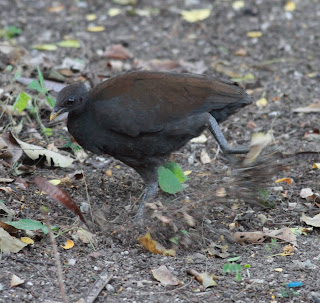The highlight however was the Hooded Pitta (ssp. sordida) that showed amazingly well behind the Divemaster's house. He'd spoken to me a day or so previously about a "green bird with a black head" that he'd seen. I got very interested at this, though tempered my enthusiasm with the knowledge that non-birders are crap at describing birds. I let myself into his hut at 6:30 one morning, settled into the rocking chair and played the call of Hooded Pitta I had on my ipod. The response was immediate, a gorgeous Hooded Pitta flew straight at me, then veered off into a bush. I played cat-and-mouse with it for a while, getting brief but excellent views. The next day (27 Dec) I set myself up again, but this time the bird sat in the open for at least a minute, allowing me to take some decent photographs.
On the 28th we went on a diving trip to Apo Reef. It was absolutely fantastic from a diving perspective, but the birding was a little slower. The island itself is supposed to contain Nicobar Pigeon, but as I had half an hour to find them, starting at 1:45pm I was out of luck. I did find lots of Barred Rails (wandering around like the Tabon Scrubfowl on Pandan) and the aurora race of Olive-backed Sunbird, which was a surprise as it is supposed to be limited to Palawan.
Seabirds were conspicuous by their absence in general, with some notable exceptions. A raft of Streaked Shearwaters on the way out was nice, as was my first Black-headed Gull in The Philippines, which followed us for a mile or so. On the way back several birds flew past at distance, including Swift Tern, Brown Booby and Pomarine Skua.


Tabon Scrubfowl in action. Common and confiding on Pandan, they are very elusive elsewhere.
Pied Fantail monitoring action in the bar
Mindoro Bulbul. Similar size and structure to the Philippine Bulbul, it lacks a lot of the reddish pigment in the head and throat, appearing almost salt-and-pepper on the head. It also has a very different call, and seems more tolerant of degraded habitat